
אנגלית לאחר עברית
עבודתה של אריאן ליטמן היא סיפור בהמשכים הרווי תהליכים המתפתחים ונמשכים מעם החיים. תחילה היא מגיבה אל מרחבים פוליטיים ה מדברים על התנגשות ועל קרע חברתי; ובהמשך, מתוך למידה מטראומה במרחבים אישיים, היא פועלת מעבר לקונפליקט ומוסיפה יסודות של מחילה ושל הכלה. כך, מזה שנים, כדי לרפא טריטוריה פצועה, ליטמן, שמממשת פעולות עבודה מתוך מוטיבים מטפוריים המיוחסים לריפוי; חובשת, תופרת ומאחה את מצעי העבודה בתהליך עמלני וקפדני. כסיסמוגרף רגיש, היא מחפשת אחר המקומות החבולים ועוטפת אותם; ואלו מצויים, משיקים ונעים במרחבים ובנופים פרטיים וקולקטיביים. ״העבודה שלי היא בין תודעה של להיות כמו ספוג ולספוג את הטראומות. הפצעים הם רבים ולכולנו יש פצעים בפנים; וכשאני עובדת, אני עובדת עם כל זה״,1 כך מציינת ליטמן, שמבקשת להבין ולקלוט את המציאות גם מתוך היציאה אל השטח המשמש עבורה סטודיו נוסף. כעת, בתערוכה ארץ אם – מתווספות אל אותם תהליכים של איחוי ועיטוף, פעולות המייצגות את הסרת החבישות ואת חשיפת הצלקות או את גילויים של הפצעים המדממים בתהליך הריפוי.
מזה שנים שליטמן מטפלת בנופים פצועים באמצעות ריפוין המטפורי של מפות. בשנים 2018-2017 היא התייחסה בעבודה ״עוברים תאומים״ אל הטריטוריה של יהודה ושומרון / הגדה המערבית; וזיהתה בקווי המתאר שלה דמיון לעובר אנושי.2 את המפה ואת העוברים היא עטפה בתחבושות לבנות וסטריליות המזוהות עם עבודתה. עתה במיצב ״בתולת ישראל״ (2023) ליטמן מותירה במפה החבושה עובר אנושי חשוף שחבישתו לא הושלמה; והוא כפצע מדמם המצוי בתהליך קרישה. המפה היא מעין גוף חי שחלקו הפצוע נפרד מארץ האם וליטמן, שמנסה להציל, ולאחות, מדמה השתלת עור בגוף העובר ותופרת את קצותיו אל המפה באמצעות חוט ירוק.
לדבריה: ״כבר 70 שנה לא ידוע של מי העובר הזה. כולם רבים עליו אבל הוא יתום״. מהתקרה ובסמוך אל המפה תלויה חצאית גאזה צחורה העשויה שכבות של תחבושו ת לבנות. הדיסוננס בין הלובן הבוהק של החצאית, בתולת ישראל, לבין האודם הקרוש של העובר מרמז על נתק ומעורר תהיות המחייבות להישיר את המבט אל המשמעויות המדממות נוכח המציאות.
את פשרו של הנתק בין האובייקטים בנוף הפגוע במיצב ״בתולת ישראל״, ניתן לברר ולנתח באמצעות המונח ׳סזורה׳ (Caesura), שמקורו בלטינית ובשורש שמשמעו לחתוך. בתחומי המוסיקה והשירה משמש מונח זה לתיאור מרווח בטור שירי או לאתנחתא במקצב מוזיקלי. זהו מודל הבנוי על פרדוקס רעיוני המדבר על קטיעה חדה ודוממת ועל הפסקה ברצף; ובה בעת על המשכיות רוחשת בזרימה טקסטואלית ומוזיקלית. מלוא העוצמה של הסזורה מתחוור בעת ההימצאות במקום בו ניכרת דממה של חתך עד שנדמה כי לא יתכן חיבור או גישור אלא היפרדות מוחלטת. הפרדיגמה הפסיכואנליטית של סזורה היא הלידה. פרויד (1926) כותב: ״בין החיים בתוך הרחם לבין הינקות המוקדמת ביותר יש המשכיות רבה יותר מכפי שהסזורה המרשימה של אירוע הלידה מאפשרת לנו להאמין״.3 דבריו של פרויד עשויים להוביל אל אפשרות הפענוח של תנועת ההמשכיות במצבים שנראים נפרדים לחלוטין ובלתי ניתנים לגישור.4 במהלך החיים אנו מצויים במרווחים סזוריאליים והללו רווחים למשל, בין האני לזולת ובין הלא מודע למודע. חווית הנתקים משתנה באופן מהותי כאשר מצליחים לגעת בתנועה ההמשכית המתרחשת אף כאשר נדמה שנוצר קרע.5 מהדברים הלל ו ובשיבה אל עבודתה של ליטמן ואל העובר הפצוע והיתום טרום לידתו, נשאלת השאלה מהי אותה חצאית בתולית וצחורה המנותקת לכאורה מגוף המפה המדמם?
כותרת המיצב עשויה לרמז אל העבר הבתולי ואל כלת ישראל טרם התעברותה וטרם הפציעה; ומכאן שהיא עשויה לייצג את משאלת העבר. לעומת זאת העובר המדמם בנוף החבול עשוי לייצג את התנפצותה של אותה תקווה בהווה. אולם, נראה שחצאית המורכבת מתחבושות היא מעין כאב רפאים האצור בקרבם של אלו שהטראומה חקוקה בבשרם. צורתה ככלי מכיל ועוטף עשויה לרמז על אימהות מכילה בהווה פצוע ועל כוונות לריפוי ולמתן כסות והגנה. מלאני קליין הצי עה את התזה שלפיה התינוק משליך על האם את כל פחדיו הקמאיים ואת תחושותיו הגולמיות; והאם הטובה דיה6 משיבה לעוללה את הרגשות באופן מעובד, כך שהוא יוכל לשאת ולעכל אותן.
יחסי האם והתינוק מתוארים כמיכל ומוכל המונעים מתוך הזדהות השלכתית.7 במיצב ״בתולת ישראל״, החצאית עשויה לבשר על הֲכָלָה ועל היכולת לשאת בקרבה את הקשיים מבלי להדוף אותם בצורה שאינה מותאמת. ליטמן יוצרת במצב זה מעין מטפורה לחתך סזורי היוצר מרחב מאתגר שאוחז בתפיסות בינאריות של חיבור ונפרדות. בדרך זו היא מייצגת חתך והשתהות ובה בעת תנועה מתמשכת בין המכיל לבין המוכל.
הקשר שבין האימהות הפרטית לבין האימהות הלאומית הוא נושא משמעותי בעבודתה של ליטמן. בשנת 2009 נכוותה בתה קליה באופן קשה בעת פעילות צופים בעין גדי. המשפחה אספה אותה ממצוקי דרגות ובדרך לבית החולים נשמעו קולות כאבה, סבלה ופצעיה הזועקים: ״אמא כואב לי, אמא כואב לי, אמא כואב לי״. בשנת 2020, כעבור 11 שנים הבת מבשרת לאם: ״אמא אני מוכנה לחשוף את הפצעים שלי״ בעקבות הבשורה ליטמן תרה אחר חבלות בנוף וחוזרת אל הצוק במצוקי דרגות. שם בנוף הפצוע היא יוצרת נקודות מפגש בין הנוף הפוליטי לבין הנוף הפרטי הביתי; ומצלמת ויוצרת את הסרט ״המוזה״ (2021). ליטמן הלבושה לבן נדמית כנביאה הנושאת בשורת תיקון ושיקום בין חבלות העבר לבין ההווה המבקש להיחלץ. לעיתים נדמה שדמותה חזקה מהנוף ולעיתים היא מצטיירת כנקודה זעירה שהנוף חולש עליה. היא מערסלת ברוך בשתי ידיה רדיד צחור ומגוננת עליו כעל תינוק האחוז בחיקה. כך היא פוסעת אל בתה החבושה, השכובה על אדמת הצוק. ליטמן מסירה מקליה את החבישות וחושפת את הצלקות מרגלה השמאלית. בהמשך היא מסירה את החבישה מעיניה והן מביטות זו בזו. כשהאם מוסרת לבתה את האריג הלבן ניתן להבחין שמדובר בשמלה. קליה ניצבת על רגליה ומסירה מעצמה תחבושות נוספות. בתהליך ההיפרדות שתיהן עטויות בשמלות לבנות ומתחבקות ארוכות בעוד עיניהן עצומות. לאחר מכן, קליה יוצאת לדרכה ומותירה את אמה ואת החבישות הנדמות כנשל על הצוק.
חשיפת הצלקות מומחשת בעבודה נוספת שכותרתה ״האמנית והמוזה שלה״ (2020). מהתצלום ניבטת האם האמנית האוחזת בחבישות של בתה הישובה מולה. על התחבושות המשולות לשלייה – ליטמן אומרת: ״כאילו שזה יוצא מהבטן שלי, מהטבור״. גם בעבודה הזו מסייעת האם המכילה לשחרור של בתה. התצלום פותח בשיטת הקולודיון Collodion) (Wet Plate שהומצאה במחצית המאה התשע עשרה. מדובר בתמיסה כימית הרגישה לאור שמורחים על גבי זכוכית, טובלים בכסף נוזלי ומכניסים לקופסה שחורה ואטומה לאור. הנוזל מתאדה בתהליך הצילום ונשאר התיעוד. שיטה זו רווחה במשך כשלושים שנה וההיסטוריונים כינו אותה ״עידן הקולודיון״. באמצעותה ניתן היה לבצע לראשונה צילומי חוץ ולפעול מחוץ לסטודיו. בשנת 1955 שימשה הטכניקה הזו לצילום בשדה הקרב, כאשר הצלם רוג׳ר פנטון תיעד את מלחמת קרים.8 על הבחירה בטכניקה הזו ליטמן מציינת: ״הקולודיון הוא חומר שפוצע את התצלום. חומר כימיקלי שהיה בשימוש כדי לסגור פצעים גם במלחמות המאה ה-19 וגם בווייטנאם. זה חומר שמשמש גם ליצירה של פצצות ובקבוקי תבערה. היה לי בחומר הזה את הכול: את הפצע, את הריפוי ואת הצילום… את היצירה״. דבריה כאן ממחישים את האופן שבו ליטמן מקיפה ומרפאת את מצעי עבודתה בשכבות רעיוניות ומטפוריות המש לימות זו את זו.
ארץ אם מהווה מעין מעבדה מטפורית ורוחשת המצויה בתנועה ובפעולה עבור הפצעים – המדממים בתהליך ריפויים. אפשר לראות בכך את ה מתח הדומם של החתך הסזוריאלי שבין שלבי פציעה לריפוי. מהמיצב ״נוף באדום״ (2023) ניבטות תחבושות סטריליות ספוגות בדם המשתלשלות מאנקולי קצבים. מתחתן מצויות קערות אמאייל אליהן נזל הדיו המדמם שיבש. התחבושות הן מעין שליות שמטפטפות לדברי ליטמן. כאן בשונה מעבודת הקולודיון, נראה שמדובר בהיפרדות ובהתנתקות טראומטית של השיליה מהרחם בטרם עת, לפני שסיימה את תפקידה. מעבודה מדממת זו מומחש התהליך שדרכו נחשפת גם הדרך המייגעת אל ההחלמה שמותירה טראומה ערה וחשופה. במיצב ״חסם״ (2023) מוצבת עגלת טיפול כירורגי מנירוסטה ועליה מונח ציוד רפואי. כאן מפגישה אותנו ליטמן במעבר בין הייצוגים המטפוריים לאלו הממשיים.
לפי תזת ה׳אני עור׳ של הפסיכואנליטיקאי דידיה אנזייה – (Anzieu), האגו הוא בעל תכונות דומות לאלו של העור. הוא מזהה שלוש פונקציות עוריות והראשונה שבהן קשורה להיותו של העור שק מכיל ומחזיק. הפונקציה השנייה קשורה אל העור המהווה שטח מגע שמסמן את הגבול ואת ההפרדה בין הפנים לבין החוץ. לפי הפונקציה השלישית, העור מסומן כא מצעי ראשוני לתקשורת בין התינוק לבין האם. את הנתונים האלו משליך אנזייה על האגו האנושי וטובע את המושג ׳אני-עור׳. שכן לדבריו גם ה׳אני׳ נוצר, מתפתח ומתקיים דרך פונקציות של הכלה, שטחי מגע, תקשורת, סימון והפרדה. הסביבה יוצרת את המעטפת החיצונית של המסרים ושל התחושות. ומכאן שעל הסביבה להותיר מרווח עבור התפתחותה של המעטפת הפנימית הנפשית, כדי – שתתקיים פונקציית הכלה לצורך התפתחותו המיטבית של האני עור. כאשר הסביבה יוצרת – מעטפת לוחצת וצמודה, האני עור נחסם והתפתחותו נמנעת. במצב זה האני עור לא מתפקד ונוזלי – הגוף נשפכים ממנו ללא שליטה. כשהאני עור לא עוטף את הנפש כראוי אנו חווים צורות שונות – חרדה.9 אם נמשיך ממשנתו של אנזייה, ליטמן כרוכה במרחבים ובאירועים טראומטיים-מכוננים המדובָבים בה שוב ושוב. היא מנכיחה אותם בעבודתה באמצעות חשיפת ה אַפקט הגופני ומזינה מבט של אי ודאות. לעיתים הסרת התחבושות מגלה את ההחלמה של האני עור. אולם – לעיתים, עוד לפני הריפוי המטפורי, ליטמן חושפת את המעטה של הגוף הפצוע, המדמם והמרוטש; ומחיה את המבט ובעקבותיו אולי, גם את המודעות. ברי כי מעבר לשיקום ולריפוי, עשויות פעולות כירורגיות של חבישה, עיטוף וסגירת פצע להוות מטפורה למחיקה, להכחשה, להדחקה, להסתרה ולהסוואה. הן ייתכנו גם כביטוי למה שלא ניתן לייצוג ולהבנה, או לביטויים של קשיי התמודדות עם המראות המשיבים אל הטראומה. העיטוף הוא כמיהה לייצוג של עולם מוגן, המסווה כמסכה את ההכרה בפגיעות ובסיוטים במציאות רוויית אימה. עתה, בארץ אם, ליטמן חוזרת אל הפציעה שאף הצלקת לא מוחקת ומתמודדת עם – החשיפה המציעה בבואה לטראומה. בפעולה זו נטוע כוח עצום שמוביל אחר עוד שלב שמאפשר להשתקם ולהתרומם. בקריאה המא מצת את הטופוגרפיה של ה סזורה, נוכל להבחין בצמתי המשמעויות שמטמיעה ליטמן מתוך מרחבי קיום פוליטיים ואישיים; ומזיהויו מאיתור של יסודות מחלחלים של פגיעות. היא מזמנת מבט והצעה להמשכיות ולהכלה בין האינטימי לציבורי, בין האישי לפוליטי, ובין הממד העכשווי של גוף פצוע ודואב לבין העתיד העשוי להימשך ממנו. כך, ליטמן מספרת על אפשרות של תנועת ריפוי ושל צמיחה, גם מתוך חיכוך מתמשך בנוף עכור הנחווה לעיתים כקטסטרופה.
טקסט: ד״ר נאוה ט׳ בראזני
1 הציטוטים של אריאן ליטמן לקוחים מתוך שיחה שהתקיימה עמה בסטודיו שלה בירושלים, 2023.
2 מתוך הסדרה ארץ מושתלת, 2015 ואילך.
3 כך, בדבריו של פרויד, פותח וילפריד ביון, הפסיכואנליטיקאי וממשיך דרכה של מלאני קליין, את מאמרו על אודות הסזורה. ראו: ביון, וילפריד (1977). סזורה. תרגום מוער ומאמרים נוספים. עורכים: אהרוני, ח. וברגשטיין, א. תל אביב: תולעת ספרים, 2012.
4 Bion, W. R. (1985). Container and contained. Group relations reader, 2(8), 127-133
5 ביון (1977).
6 את הביטוי ״אם טובה דיה״ טבע דונלד וודס ויניקוט. ראו למשל: ד. ו. ויניקוט, ״משחק ומציאות״, תל אביב: עם עובד, 2007, עמ' 25, 44-43.
7 על "הזדהות השלכתית" (projective identification) לפי מלאני קליין ראו למשל:
John Phillips, Lyndsey Stonebridge (1998), Reading Melaine Klein, London and New York: Routledge, pp. 94-123.
ביון יוצא מהמושג "הזדהות השלכתית" מתוך התזה של מלאני קליין; וטובע את המושגים "מיכל ומוכל"(Container/Contained) , אשר הדינמיקה הפועלת ביניהם יוצרת את תהליך ההכלה. תהליך שהינו מרכזי לצורך התפתחותו הרגשית והאינטלקטואלית של האדם. ראו: סימינגטון ג'ואן. ונוויל, ״החשיבה הקלינית של וילפרד ביון״, תל אביב: תולעת ספרים, 2000, פרק 6: מיכל/מוכל.
8 על טכניקת הקולודיון ראו למשל: Helmut Gernsheim, The Rise of Photography 1850-1880: The Age of Collodion. Thames and Hudson, 1988; John Hannavy (ed.), Encyclopedia of Nineteenth-Century Photography Vol 1 A–I, New York London: Routledge Taylor & Francis Group, 2008; Pia Skladnikiewitzt, Dirk Hertel and lrene Schmidt (1998), The wet collodion process – A scientific approach, Journal of Imaging Science, September 1998, 42(5):450-458.
9 דידייה אנזייה, ״האני עור״, תל אביב: תולעת ספרים, 2000.
Ariane Littman’s work is a continuing story rich with processes that are drawn up and developed from life. She begins by responding to political realms that touch on themes of confrontation and social division; later, as she learns from trauma in personal realms, she moves beyond conflict to add elements of compassion and containment. Over a period of years, as she strives to heal a wounded territory, Littman uses artistic actions rooted in metaphorical motifs attributed to healing in order to dress, sew, and stitch the foundations of her work through a laborious and meticulous process. Like a sensitive seismograph, she seeks out damaged images of realities which coexist within individual and collective realms and landscapes and dresses their wounds.
“My work lies between an awareness of being like a sponge and that of absorbing traumas. The wounds are many: we all have wounds inside us. And as I work, I work with all this,”1 Littman explains. She also seeks to understand and absorb reality by going out into the field, which serves her as an additional studio. Now, in the exhibition Mother-Land, these processes of suturing and dressing are complemented by actions representing the removal of the bandages, the exposure of the scars or the uncovering of bleeding wounds during the healing process.
For years Littman has attended to injured landscapes through the metaphorical healing of maps. In 2017-2018, her work Twin Embryos examined the area of Judea and Samaria / the West Bank, whose contours she found to resemble a human embryo. She enveloped the map and embryos in the sterile white bandages that are a hallmark of her work. Now, in her installation Virgin of Israel (2023), Littman leaves an exposed human embryo, not fully bandaged, on the bandaged map, like a bleeding wound still in the process of coagulation. The map resembles a living body whose injured part has been separated from the motherland. As she seeks to rescue and stitch it together, Littman mimics a skin transplant in the embryo, attaching its edges to the map with green thread. She comments: “For seventy years, no-one knows who this embryo belongs to. Everyone fights over it, yet it is an orphan.” Above the map hangs a bright white gauze skirt, made from layers of white bandages. The dissonance between the dazzling white skirt, the Virgin of Israel, and the coagulated red of the embryo conveys a sense of disconnection and raises questions that oblige us to confront the bleeding meanings of reality.
The meaning of the disconnection between the objects in the damaged landscape in the installation Virgin of Israel can be explored and analyzed through the term Caesura, which comes from a Latin root meaning “to cut.” In music and poetry, this term is used to describe a gap in a column of poetry or a pause in a musical rhythm. This concept is based on a conceptual paradox involving a sharp, silent cutting action and the interruption of a sequence – yet at the same time an audible continuity in the textual and musical flow. The full strength of the Caesura becomes apparent as we stand in a space dominated by a silent cut, gradually creating the sense that no connection or bridging is possible, only total separation. The psychoanalytical paradigm of the Caesura is birth. Freud (1926) writes: “Between life in the womb and the earliest infancy there is more continuity than the impressive Caesura of the event of birth permits us to believe.”2 Freud’s remarks may offer an avenue for deciphering the trajectory of continuity in situations that appear to be completely separate and unbridgeable.3 During the course of our lives we find ourselves in such Ceasural gaps, which are common, for example, between the ego and the other and between the subconscious and the conscious. The experience of disconnection changes significantly when we manage to touch the trajectory of continuity that exists even when a rift appears to have been created.4 From these insights, and to return to Littman’s work and the injured embryo, orphaned before its birth, the question that arises is: what is this virginal white dress, that is ostensibly disconnected from the bleeding body of the map?
The title of the installation may allude to the virginal past and to the Bride of Israel prior to her conception and injury; thus it may represent a past longing. Conversely, the bleeding embryo in the damaged landscape may symbolize the shattering of this hope in the present. However, a skirt made out of bandages would seem to constitute a kind of ghost pain within those whose bodies bear the imprint of trauma. Its shape, reminiscent of a containing and enveloping vessel, may hint at a containing motherhood in an injured present and at the determination to achieve healing and to grant cover and protection. Melanie Klein suggested that babies project all their primeval fears and raw feelings onto their mother; the “good enough mother”5 returns these emotions to her infant in a processed form, so that the child can tolerate and absorb them. The mother-baby relationship is described in terms of “container” and “contained,” driven by projective identification.6 In the installation Virgin of Israel, the skirt may suggest containment and an ability to encompass difficulties without repelling them in an uncontrolled manner. In her installation, Littman uses this situation to forge a type of metaphor for a Caesural gap, creating a challenging space that clings to binary perceptions of connection and separateness. By so doing, she simultaneously represents both a gap and pause and an ongoing movement between container and contained.
The connection between individual motherhood and national motherhood is a significant theme in Littman’s work. In 2009, her daughter Kalia was badly burned during a scout activity at Ein Gedi by the Dead Sea. The family picked up Kalia from the Metzukei Dragot site, and throughout the journey to hospital she cried out in pain, suffering, and injury: “Mom it hurts, Mom it hurts, Mom it hurts.” Eleven years later, Kalia tells her mother: “Mom, I’m ready to uncover my wounds.” Following this announcement, Littman searches for wounds in the landscape and returns to the cliff at Metzukei Dragot. There, against the backdrop of the injured landscape, she creates points of encounter between the political landscape and the individual-domestic landscape, and so she creates the film The Muse (2021). Dressed in white, Littman resembles a prophetess bearing a message of repair and reconstruction between the wounds of the past and the present that longs to break free. Sometimes the figure of Littman seems to be stronger than the landscape, while at others she appears as a tiny speck dominated by her surroundings. She cradles a white veil in both hands, protecting it like a baby in her lap, and walks toward her bandaged daughter, lying on the ground by the cliff. Littman removes Kalia’s bandages, exposing the scars on her left leg. Then she removes the bandage from her eyes and mother and daughter look at each other. As the mother hands the white fabric to her daughter, it becomes clear that it is a dress. Kalia stands up and takes off more bandages. Through the process of separation, both figures wear white dresses and share a long embrace, both with their eyes closed. Then Kalia sets off on her way, leaving behind her mother and the bandages, which have the appearance of a shed snake skin.
The exposure of wounds is illustrated in another work entitled The Artist and Her Muse (2020). The photograph shows the mother-artist holding the bandages of her daughter, who sits opposite her. Littman remarks on the placenta-like bandages: “As if it’s come out of my stomach, from my navel.” Again, the containing mother helps free her daughter. The photograph was developed using the wet plate collodion method, which was invented in the mid-nineteenth century. The method uses a light-sensitive chemical solution that is applied to glass, dipped in liquid silver, and placed in an opaque black fixer box. The liquid evaporates during the photographic process, leaving the image. This method was very common for some thirty years – a period known by historians as “the Collodion Age.” The method made it possible for the first time to take photographs outdoors and to move outside the studio. In 1855 this method was applied in the battlefield when the photographer Roger Fenton documented the Crimean War.7 Littman explains her choice of this technique: “Collodion is a substance that injures the photograph – a chemical that was used to seal wounds in the wars of the nineteenth century and again in Vietnam. This chemical was also used to make bombs and Molotov cocktails. Collodion offered me everything: the wound, the healing, and the photography… the act of creativity.” Her remarks illustrate the way Littman envelopes and heals her work with complementary conceptual and metaphoric layers.
Mother-Land functions as a kind of frantic metaphorical laboratory engaged in movement and action for bleeding wounds through their healing process. This state may be likened to the silent tension of the Ceasural break between the stages of injury and healing. The installation Red Landscape (2023) features blood-soaked sterile bandages suspended from butchers’ hooks. Underneath them enamel bowls collect the dried bleeding ink. Littman explains that the bandages are like dripping placentas. In contrast to the collodion project, this work seems to suggest the traumatic and premature separation and disconnection of the placenta from the womb before it has completed its function. This bleeding work exemplifies the process that exposes the exhausting path to recovery – a process that leaves behind a vital, raw trauma. In the installation Hemostats (2023), medical equipment is placed on a stainless-steel surgical trolley. Here Littman moves us into the transitional space between metaphorical and concrete representations.
According to the “skin-ego” theory developed by the psychoanalyst Didier Anzieu, the ego has similar properties to the skin. Anzieu identifies three functions of the skin, the first of which relates to its essence as a containing, holding bag. The second function relates to the skin’s function as a contact surface marking the border and separation between the inside and outside. The third function regards the skin as a preliminary means of communication between the baby and the mother. Anzieu then projects these functions onto the human ego, coining the phrase “skin-ego.” He argues that the ego, too, is created, developed, and sustained through functions of containment, contact surfaces, communication, marking, and separation. The environment creates the external shell of messages and feelings. Accordingly, the environment must leave room for the development of the internal, psychological shell in order to permit the function of containment that is vital for the optimal development of the skin-ego. When the environment creates a tight, pressing shell, the development of the skin-ego is blocked. In this condition the skin-ego fails to function and bodily fluids are excreted uncontrollably. When the skin-ego does not envelop the soul properly, we experience various forms of anxiety.8 Taking Anzieu’s theory as our point of departure, Littman is enmeshed in traumatic and formative realms and events that repeatedly well up and speak through her. She makes these present in her work by exposing the physical affect and feeding a perspective of uncertainty. In some instances, the removal of the bandages reveals the healing of the skin-ego. At other time, however, even before the metaphorical healing Littman removes the cover over the injured, bleeding, and shattered body; she revives our perspective and thereby, perhaps, our awareness.
In addition to recovery and healing, surgical actions of the bandaging, wrapping, and suturing of a wound may also serve as a metaphor for deletion, denial, concealment, and camouflage. They may also express the unrepresentable and incomprehensible or the difficulties of coping with sights that take us back to a trauma. Enveloping suggests a longing for the representation of a protected world that, like a mask, camouflages the recognition of the injuries and nightmares of a terrified reality. Now, in Mother-Land, Littman returns to the wound that cannot be erased even by its scar, confronting the exposure that offers a reflection of trauma. This action embodies an enormous strength which, after a further stage, allows the human to recover and rise up. If we read the work through the topography of the Cesura, we may distinguish the intersections of meanings Littman applies from the realms of political and personal existence, and from the identification and discovery of seeping elements of vulnerability. She conveys a message of continuity and containment between the intimate and the public, the personal and the political, and between the present dimension of a wounded and aching body and the future that might spring therefrom. By so doing, she manifests acts of healing and growth, even through the repeated encounter with a barren landscape that is sometimes experienced as a catastrophe.
Text: Dr. Nava T. Barzani
Translated from the Hebrew by Shaul Vardi

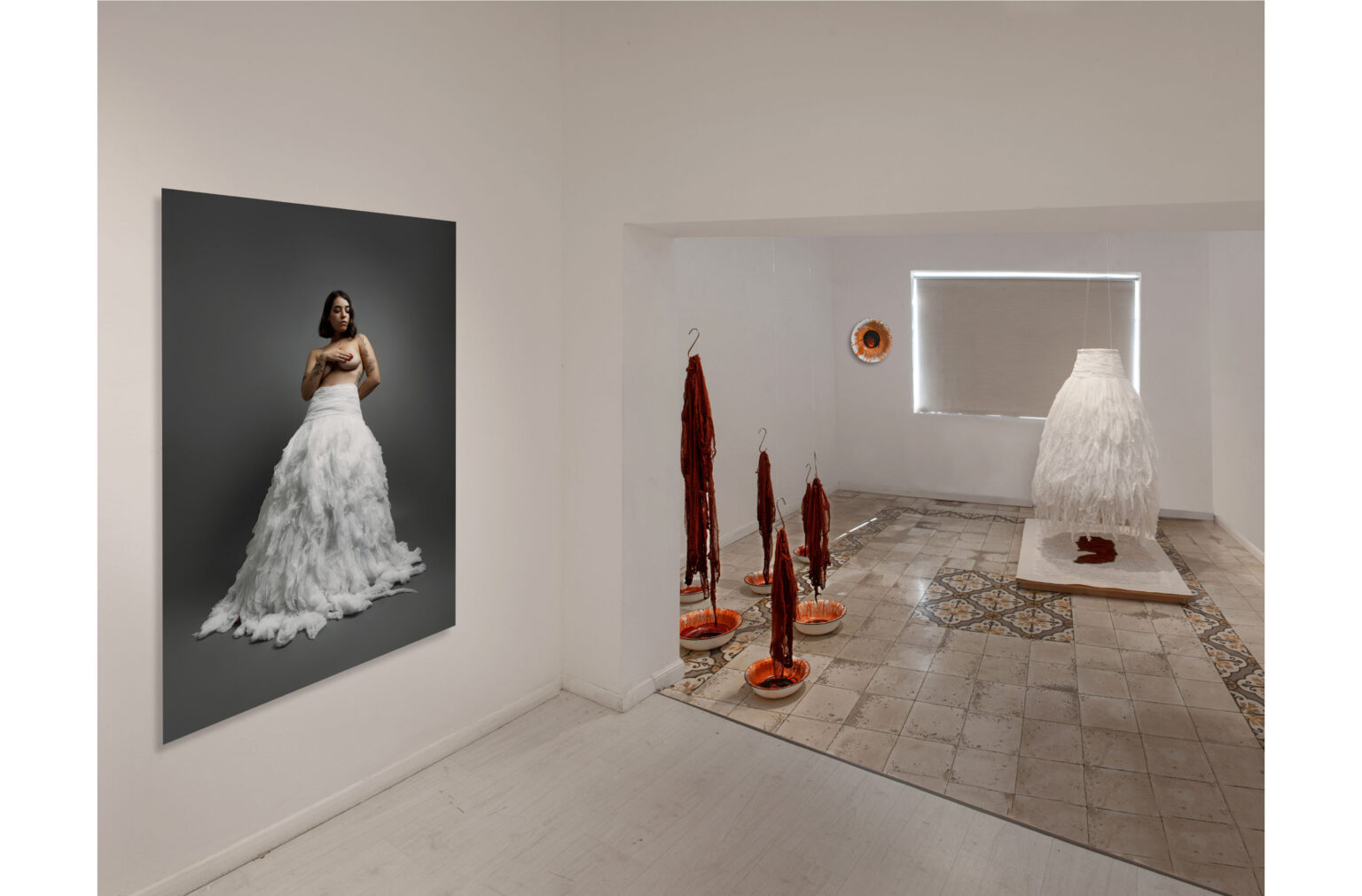
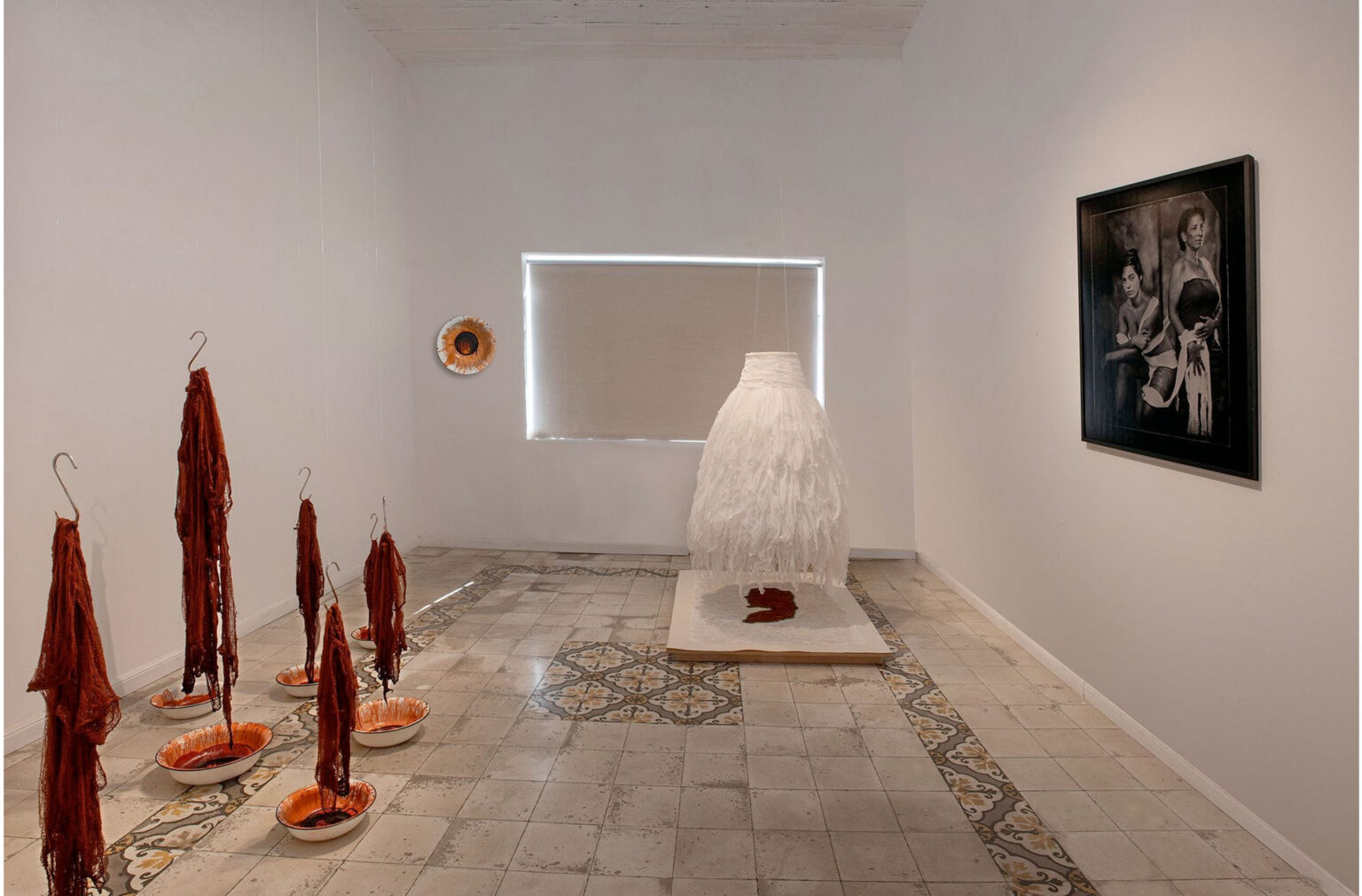

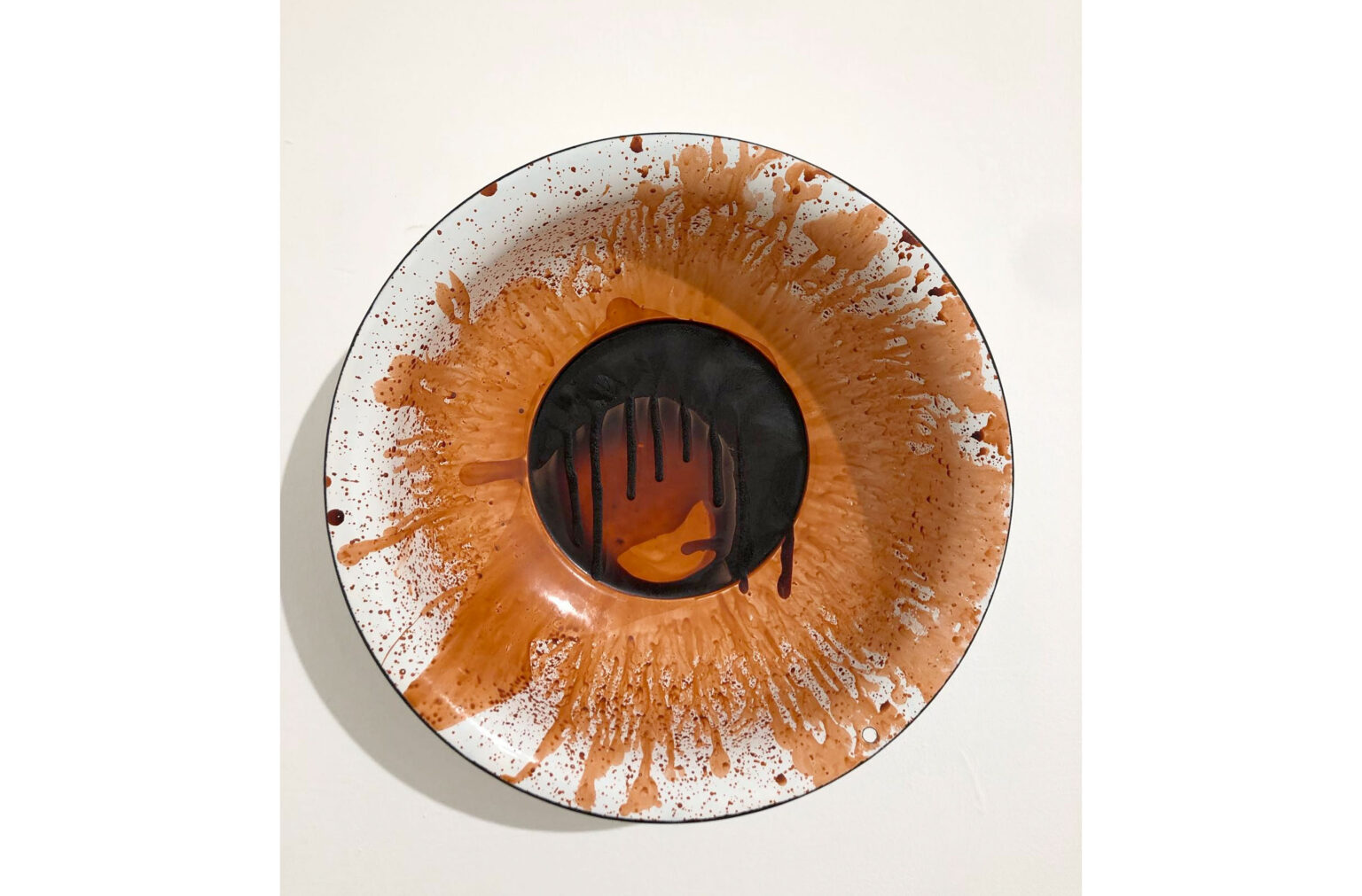
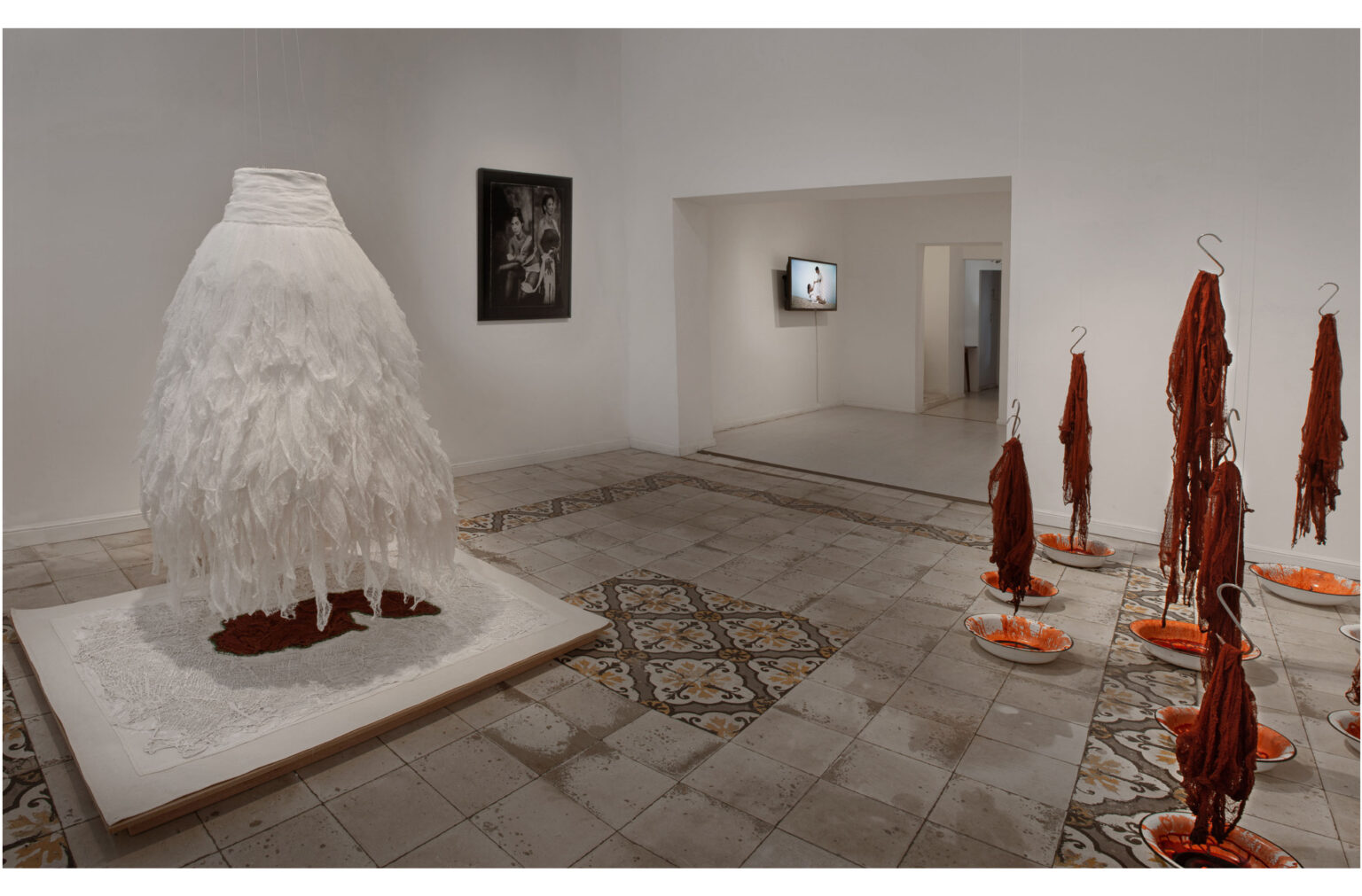
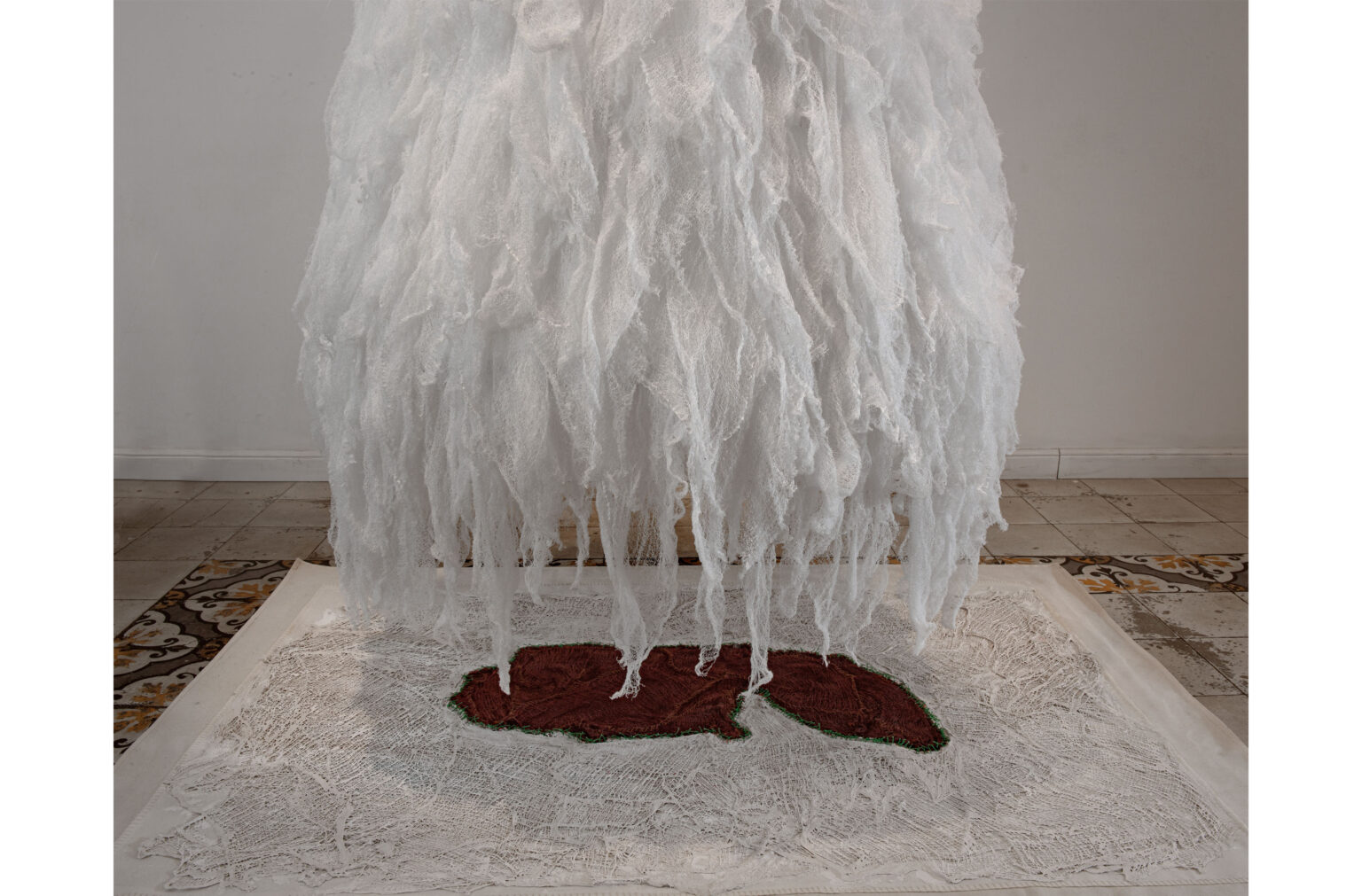
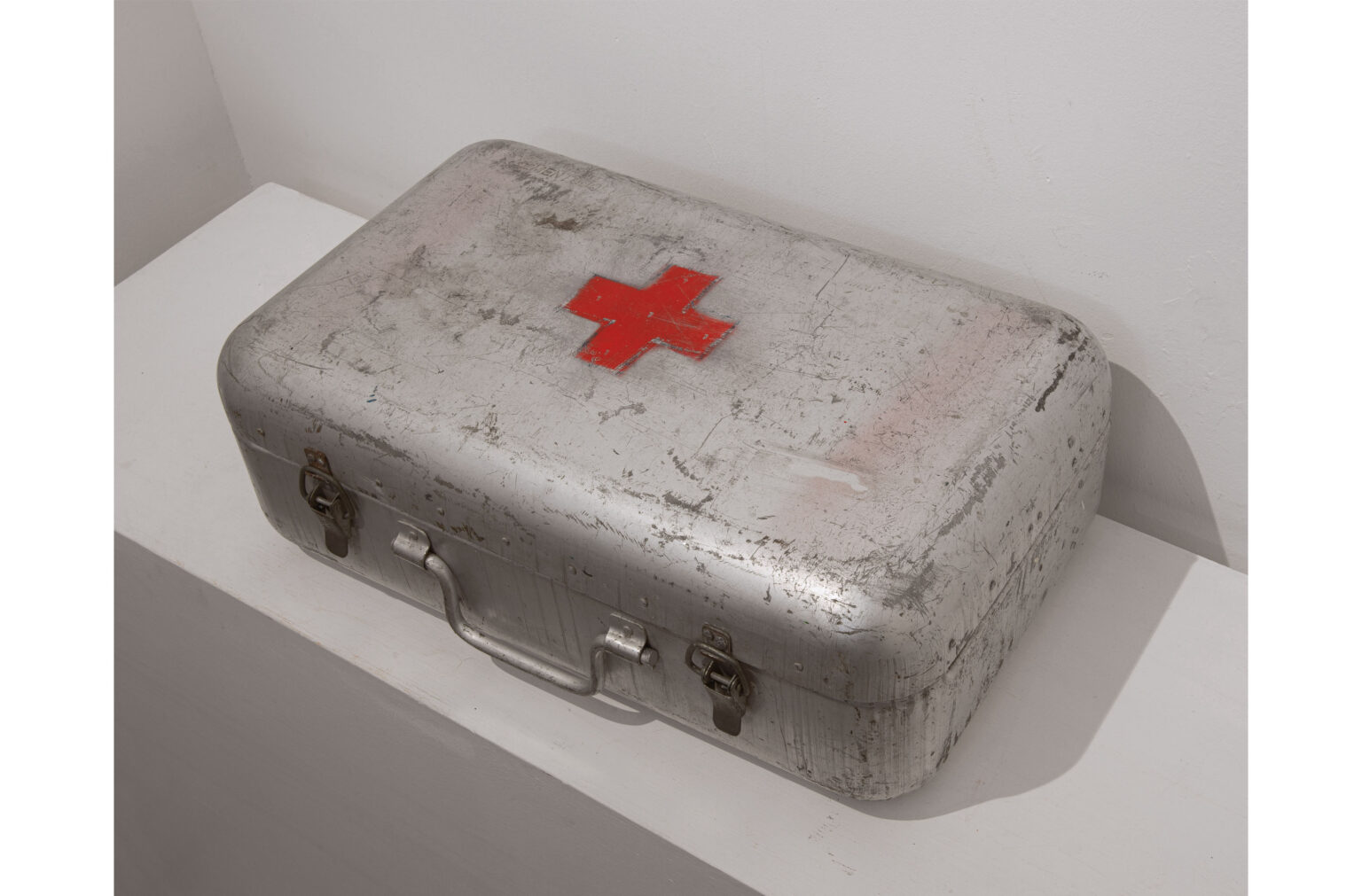


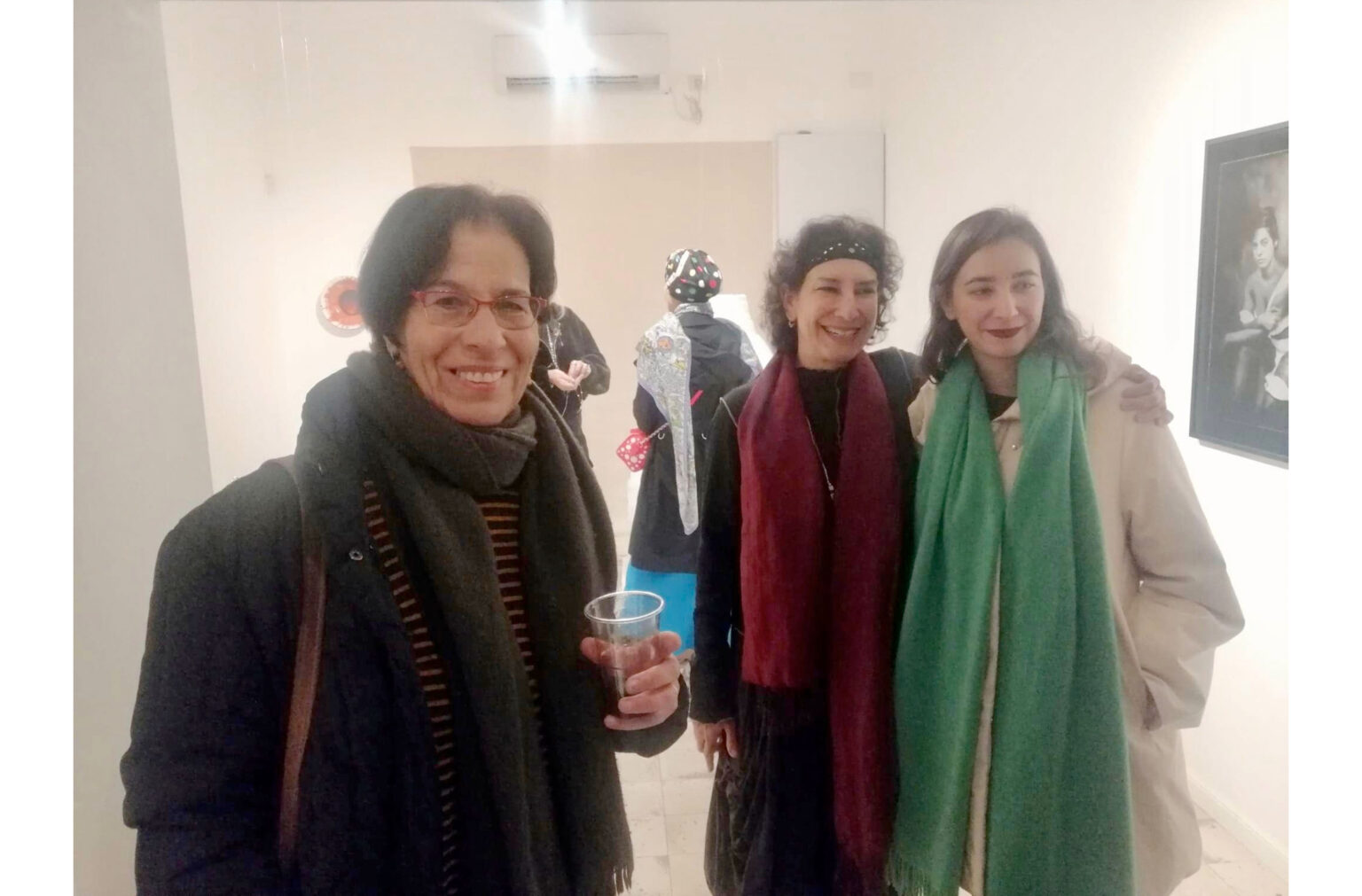
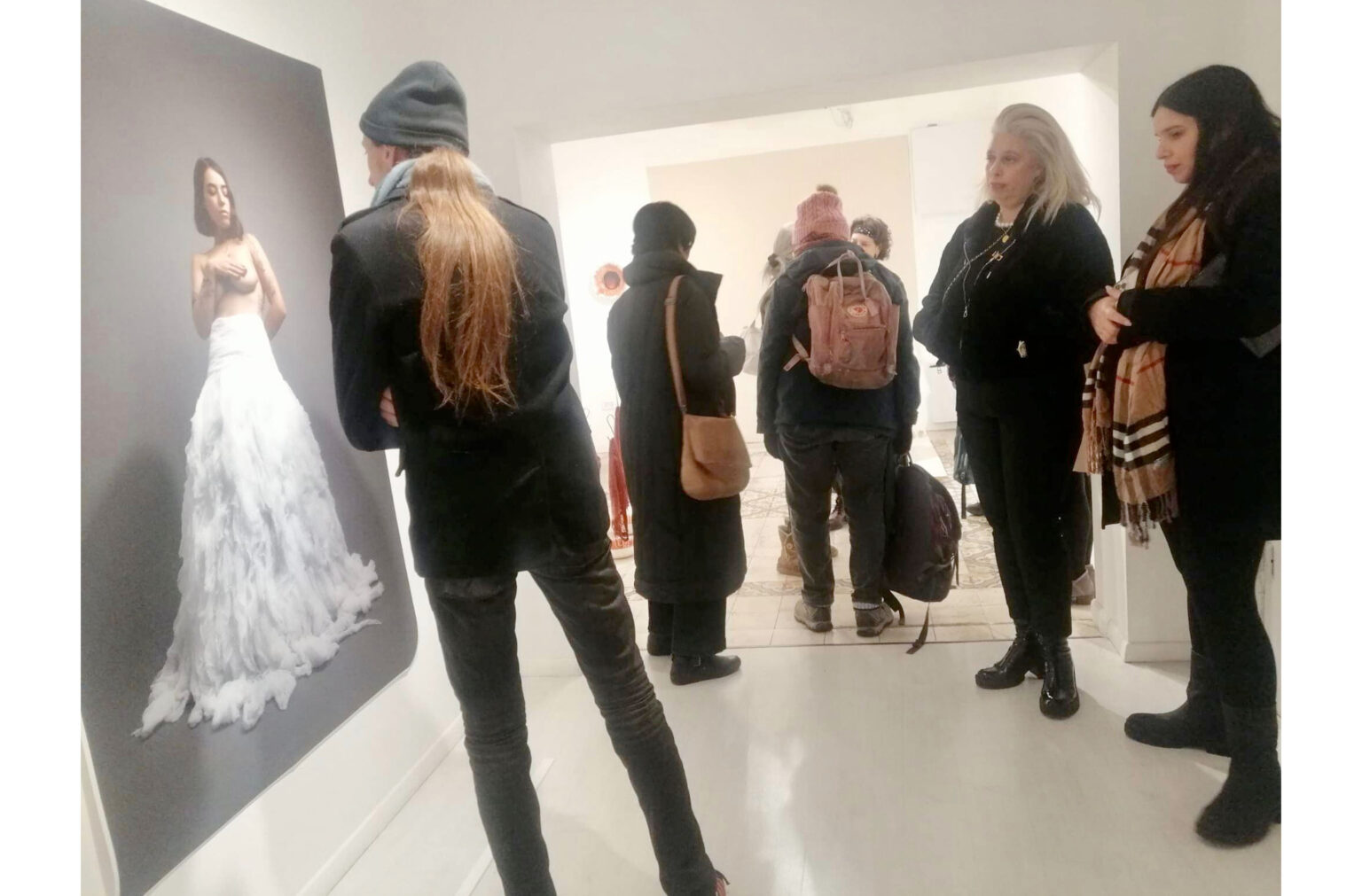

אריאן ליטמן, המוזה. 2020. צילום: אבגר אידן
Ariane Littman, The Muze. Photographer: Avgar Idan
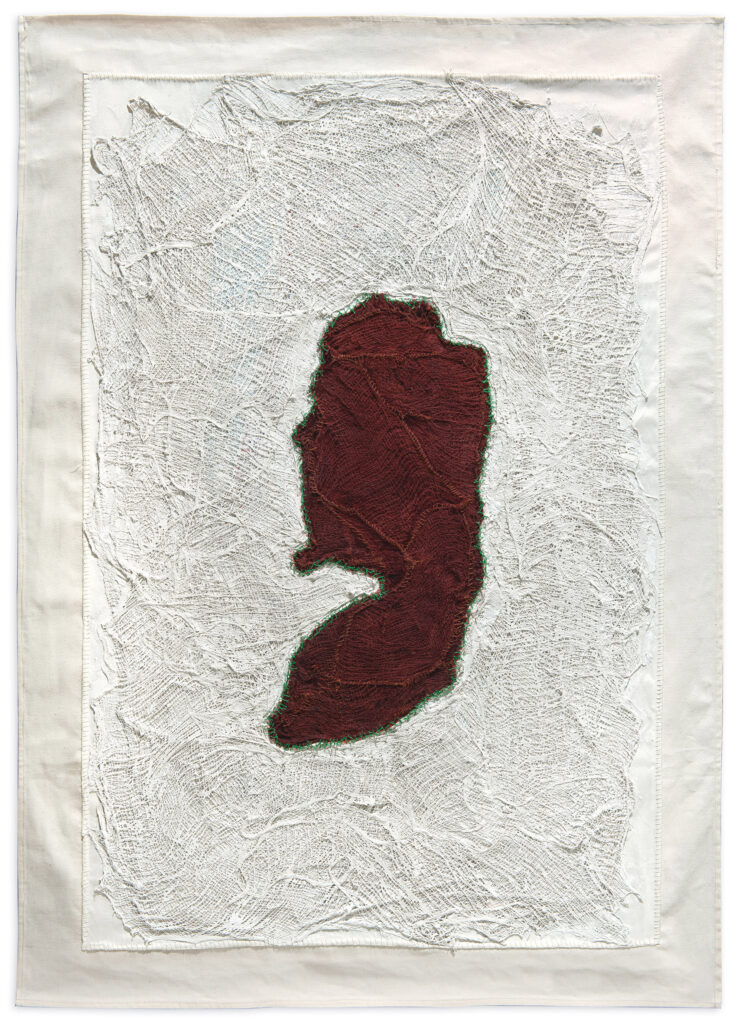
עובר אדום, 2023, מתוך הסידרה ארץ מושתלת.
מפה, חבישות גאזה, בד, גבס, דיו אדום וחוטים. צילום: מיכאל עמר
Red Embryo, 2023, From the Grafted Land Series.
Map, gauze, fabric, plaster, red ink and thread. Photo: Michael Amar

מוזה לבושה גאזה, 2023, תצלום צבע. צילום: אריאן ליטמן
The Muse dressed in Gauze, 2023, Photograph. Photo: Ariane Littman
